March 2023
Sustainable Commerce Strategy: A Commonsense Lens on Sustainability
Sustainability and shopper marketing are two powerful forces in the modern retail landscape. As consumer interest in sustainability continues to grow, brands are turning to shopper marketing to help them meet their sustainability goals. With a deeper understanding of the intersection between sustainability and shopper marketing, brands can gain a competitive edge and create an emotional bond with their customers.
This article will explore best practices for brands looking to maximize the potential of both sustainability and shopper marketing to ensure their campaigns are effective, engaging and have positive impact on the bottom line.
Why is Tracy-Locke talking about Sustainable Commerce?
- Awareness. Tracy-Locke has the tools to understand how to effectively educate consumers.
- Engagement. Tracy-Locke understands the retailer, brand and shopper tensions that drive to consideration.
- Conversion. Tracy-Locke is in the position to help influence sustainable messaging at point of sale.
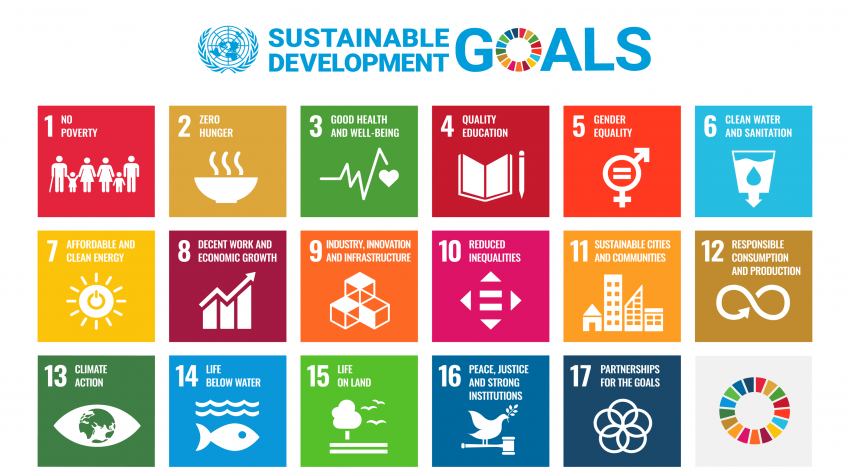
$178 Trillion = Cost of Inaction
The cost of inaction on climate change could be as high as $178 Trillion (US Dollars) for the global economy by 2070. The price of inaction is too high.
According to the Deloitte Center for Sustainable Progress report, “[The] toll on human lives could be significant—disproportionately impacting the most vulnerable; leading to loss of productivity and employment, food and water scarcity, and worsening health and well-being; and ushering in an overall lower standard of living globally[1].”
Shoppers Expect Brands to Act.
The majority of shoppers want brands and companies to do more to support sustainable efforts. 89% of shoppers say that companies and brands should do a lot more to reduce their carbon impact[2].
84% of shoppers say that sustainability is important when they are making their purchase decisions[3].
According to EY Future Consumer Index, 61% of shoppers want more information to help them make better sustainable choices[4]. Consumers are looking for guidance from the brands and companies that they trust.

The Intention-Action Gap
Consumers say they want more sustainable products, yet they don’t consistently buy them. Why? Because the effort required to buy these products sometimes outweighs the perceived benefits. This creates the intention-action gap. Narrowing the intention-action gap is important not just for meeting corporate sustainability goals, but it also is important for the planet and future generations of consumers.
There are many examples of the intention-action gap where consumers did not buy the proffered low carbon footprint product and instead chose goods and services that were cheaper or more convenient.
88% of Generation X consumers said they would be willing to spend an extra 10% or more for sustainable products in the EY Consumer Index[5]. However, only 20% check sustainability claims made on packaging or in advertising[6].
Sustainability Can be Complex for Shoppers.
While in the nascent stage of sustainability efforts, some shoppers are overwhelmed by the claims for products.
1 in 4 shoppers say that the most important product selection features are from retailers that “offer a selection of products free of harmful or synthetic materials (e.g., pesticides, dyes, food additives).[7]”
18% of shoppers consider products with sustainable packaging an “extremely important” feature. Locally sourced products are “extremely important” for 16% of consumers.
The ability to digitally search for sustainability tags and filter products for sustainability is ‘extremely important’ to 14% of consumers. This indicates that there is an opportunity to decrease search friction for sustainable products with SEO and feature tagging by both brands and retailers.
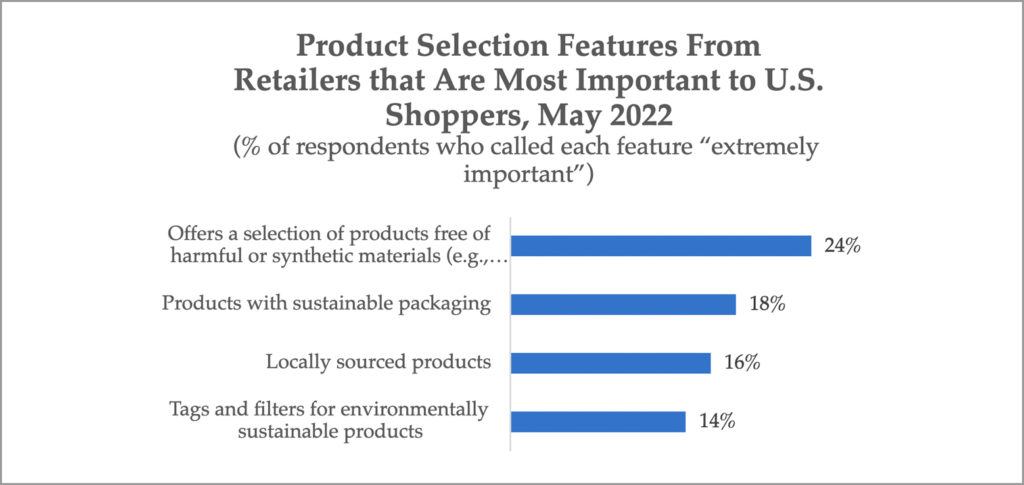
The Many Dimensions of Sustainability
As brands and retailers consider how they participate in the movement for sustainable long-term growth, they should consider the not only the environmental impact, but also economic and social impacts.
- Environment is what often comes to mind when thinking about sustainability. Global climate change, natural resource depletion, habitat destruction, and human health concern are common environmental elements.
- Social sustainability is dedicated to identifying and managing business impacts, both positive and negative, on people. Issues about improving the quality of life, reducing inequality, cultural sustainability and helping people make better choices about their health, education, and work.
- Economic sustainability refers to balancing economic growth and generating profit with the impact on the environment and people. Business ethics, economic development, competitiveness, living standards, and community investment are examples of economic sustainability.
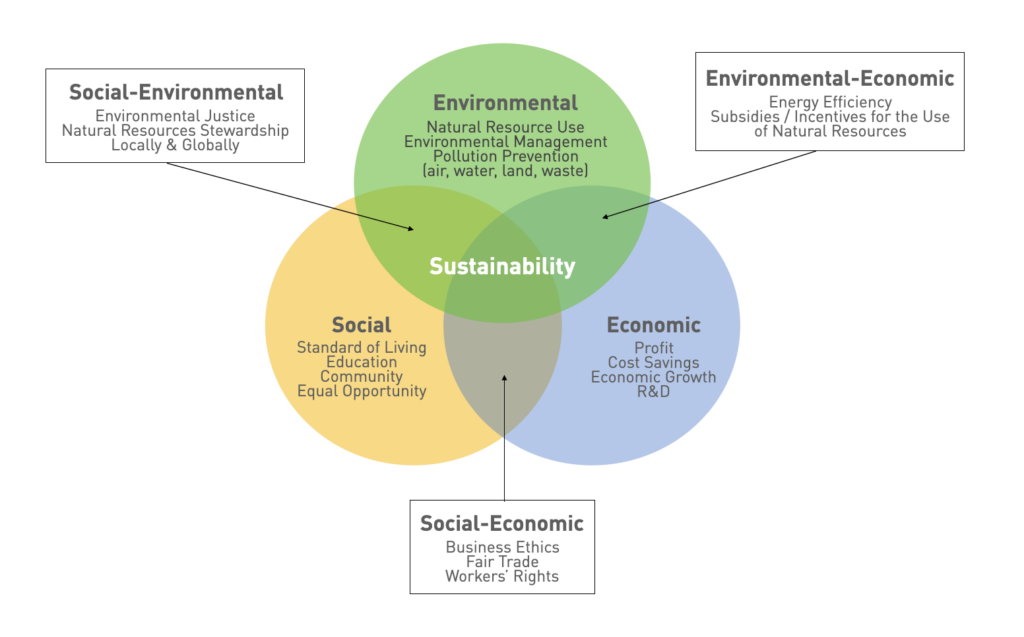
In addition to the three dimensions, there is overlap between multiple dimensions. The Venn diagram below shows how the overlap between environmental, social, and economic sustainability can manifest in the marketplace.
The following five key principles can increase the efficacy of sustainable commerce:
- 1. Use Marketing Influence for Good
- 2. Responsible Commerce is Fundamental
- 3. Sustainability is Table Stakes
- 4. Guide Shoppers to Buy Better, Not Buy More
- 5. Nudge Shoppers to Make Better Purchases
Principle #1: Use Marketing Influence for Good
Ben & Jerry’s continues to use its marketing influence for good. To support and encourage Black voters during the midterm election, they brought back their limited-batch flavor “Change is Brewing.”
This time they are working with Black Voters Matter in Georgia to make sure that Black voters will have their voices heard loud and clear despite the state’s laws that make it harder for them to cast a ballot. [8]
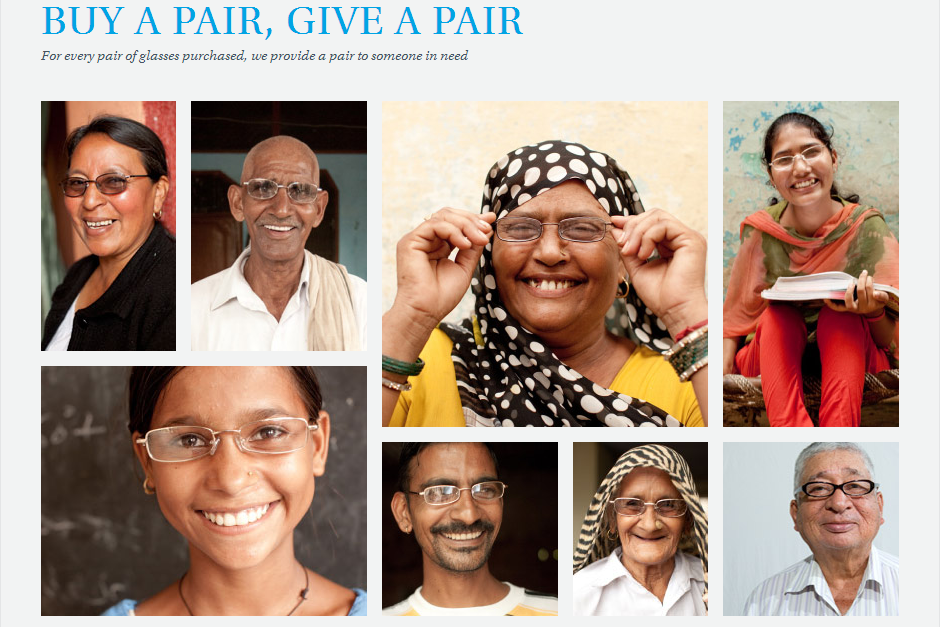
Another best practice example of using marketing for good is from Warby Parker[9]. Warby Parker has set up an Impact Foundation that works with government agencies, nonprofits and local community groups to increase access to vision care for adults and children from underserved communities.
In addition, its “Buy a Pair, Give a Pair” program donates one pair of glasses per pair bought and, to date, has distributed more than 10 million pairs of glasses.
Principle #2: Responsible Commerce is Fundamental
Life Time[10], one of the largest health lifestyle providers in North America, has sustainability built-in at the forefront of its business model. From the reduction of towel sizes to the elimination of single-use plastics, the company has replaced interior and exterior lighting with LEDs and has installed advanced energy-management systems to optimize energy usage. As a result, they were able to reduce energy consumption by 38 percent and lower water usage by nearly 60 percent.
In July 2022, their efforts to reduce Life Time’s carbon footprint earned them recognition from the U.S. Department of Energy’s Better Buildings Challenge, which named Life Time the top-ranked company in the country for energy reduction.

Panera Bread[11] partnered with World Resources Institute (WRI) to overhaul its menu. They labeled their low-carbon entrées as Cool Food Meals to make it easier for their guests to understand the climate impact of their meals.
WRI’s leading-edge methodology quantifies a maximum recommended daily carbon budget for an individual’s diet, which aligns with globally recognized goals to curb climate change.
By enabling their customers to not only eat well but do it in a way that is environmentally friendly, Panera Bread aims to drive change by crafting even more Cool Food Meals menu items and continuing to collaborate with the WRI on raising awareness across the industry to help expand the Cool Food Meals initiative to other food companies.
Principle #3: Sustainability is Table Stakes
Sustainability is now a standard expectation, especially with younger shoppers. Generation Z is influencing the older generations to place more importance on sustainability in their purchasing decisions[12].
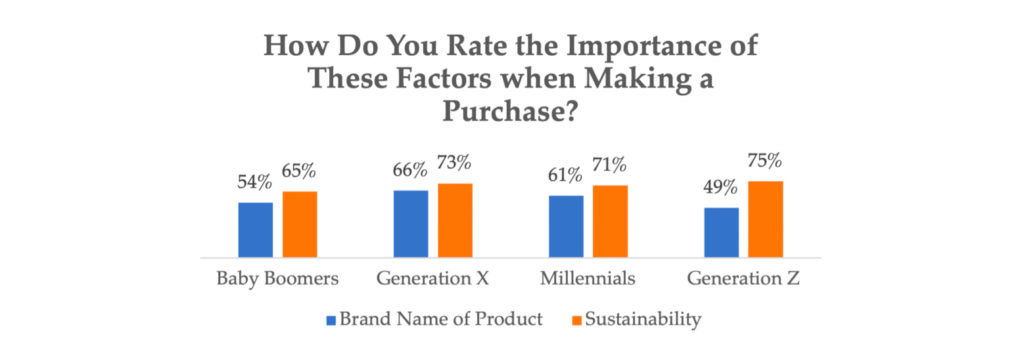
Additionally, all generations are willing to pay more for sustainable products compared to 2019[13].
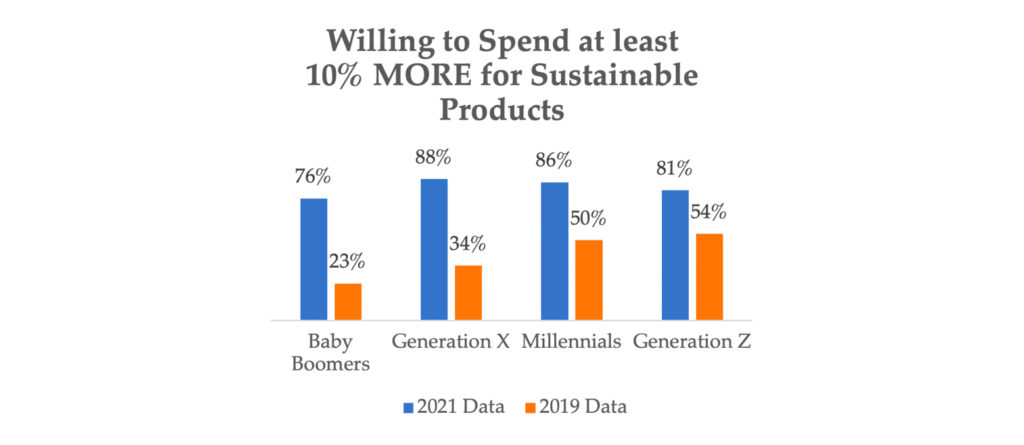
Principle #4: Guide Shoppers to Buy Better, Not Buy More
Fast fashion is inexpensive clothing produced rapidly by mass-market retailers in response to the latest trends[14].
- – 103 is the average articles of clothing owned by women in the U.S.
- – 81 pounds of clothes are thrown away by an average U.S. consumer
- – $134 is the average amount a U.S. household spends on clothes every month
- – 20% of the global waste is produced by fast fashion
Pact[15] is a leading slow fashion brand that goes to great lengths to make sure its entire supply chain — from the growing and harvesting of organic cotton, to the final sewing and all the processes in between — are as responsible and clean as possible.
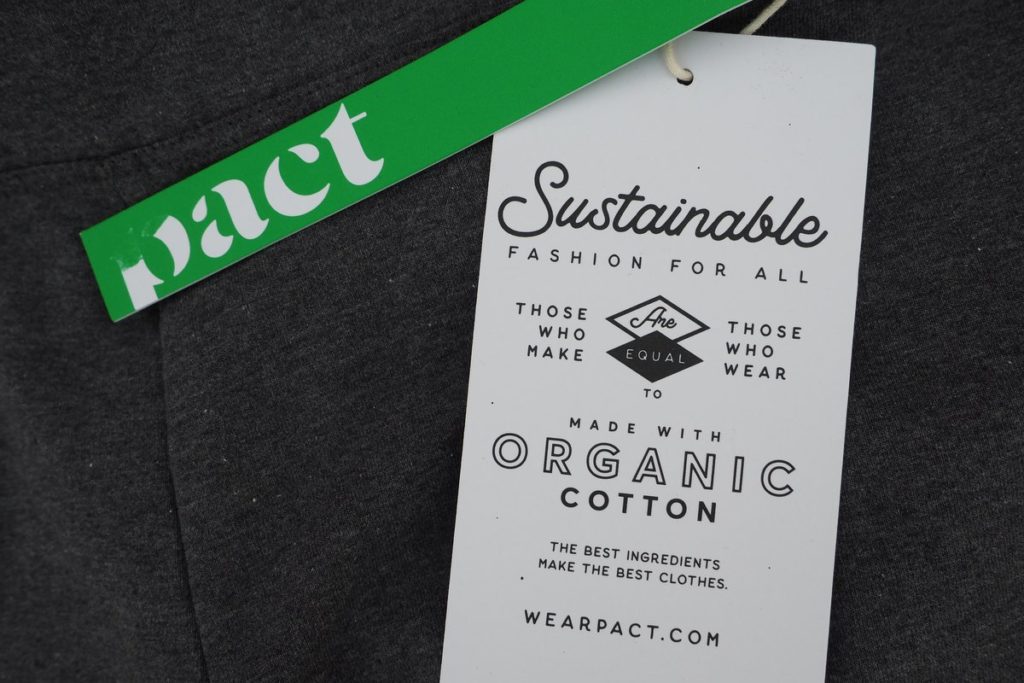

Oliberté, a Canadian shoe company, uses the highest- quality materials and the Goodyear Welt Construction handcrafting method, which gives their shoes exceptional longevity. They promote quality using the claim “Designed to Last Forever” which is also supported by a lifetime warranty.
Principle #5: Nudge Shoppers to Make Better Purchases
“Nudges” are simple, low-cost interventions that can alter people’s decision-making without attaching a substantial economic reward or penalty to the process.
As consumers increasingly demand more environmentally and socially conscious choices, nudges can nurture and facilitate their desire to live sustainably, accelerating demand for sustainable products and services.
Companies already shape behaviors, so they can encourage environmentally and socially conscious behaviors as well.
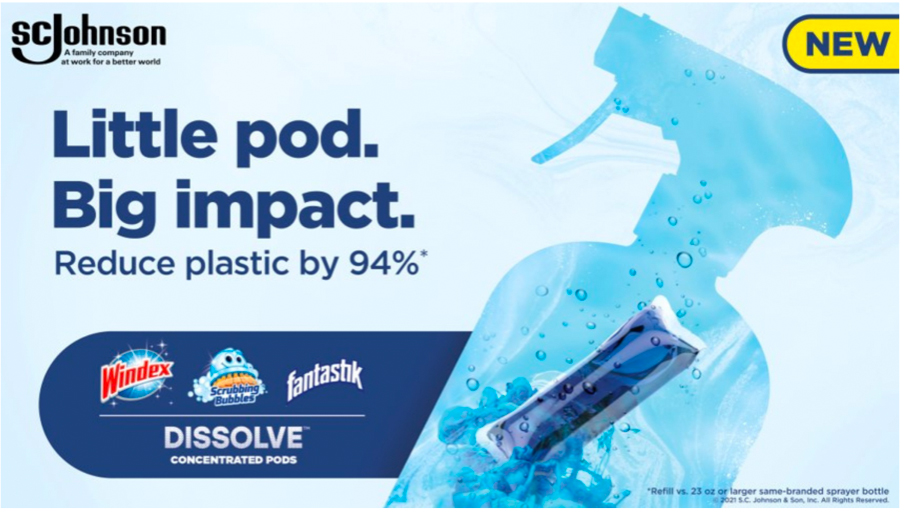
DISSOLVE is an example of product innovation in SC Johnson’s efforts to help create a waste-free world. They have eliminated more than 6.1 million kilograms of unnecessary or problematic plastic packaging since 2018. SCJ has made 100% of plastic packaging recyclable, reusable or compostable.
Sustainable Commerce Action Plan.
Tracy-Locke has identified five steps to include in a retailer or brand planning process to ensure that sustainable commerce is most effective.
- 1 – Path to Purchase: Find areas in the shopper journey where you can educate consumers about your ownable sustainability initiatives.
- 2 – Point of Difference: Highlight your differences from competitors in a way that influences the consideration and conversion for your consumers.
- 3 – Add To Consideration: Leverage shopper insights to create meaningful sustainability messages that will drive awareness, consideration, and conversion.
- 3 – Retailer Added Value: Identify how your sustainability programs dovetail with key retailer initiatives to build scale and share of voice.
- 5 – Shopper-Friendly Language: Develop messaging to help nudge shoppers to sustainable behavior.
In closing, brands and retailers can build loyalty and reputation responsibly by using shopper marketing and principles for sustainability.
[1] Deloitte Center For Sustainable Progress Report – May 2022. https://www2.deloitte.com/global/en/pages/about-deloitte/press-releases/deloitte-research-reveals-inaction-on-climate-change-could-cost-the-world-economy-us-dollar-178-trillion-by-2070.html
[2] E-Marketer Dec 2021
[3] E-Marketer Dec 2021
[4] EY Future Consumer Index — 2021
[5] EY Future Consumer Index — 2021
[6] Sustainability Report Compendium, Wharton School, 2022
[7] Insider Intelligence, “U.S. Retail Sustainability Perceptions Benchmark 2022,” August 2022
[8] Ben & Jerry’s
[9] HubSpot
[10] U.S. Department of Energy
[11] Panera Bread
[12] Sustainability Report Compendium, Wharton School, 2022
[13] Sustainability Report Compendium, Wharton School, 2022
[14] WBL – Fast Fashion Statistics
[15] Good Trade
